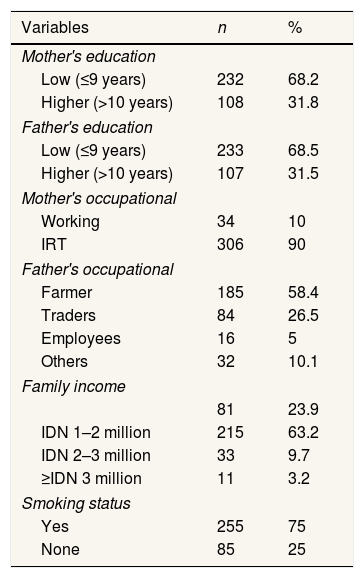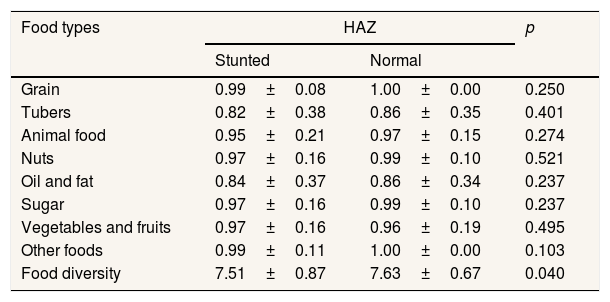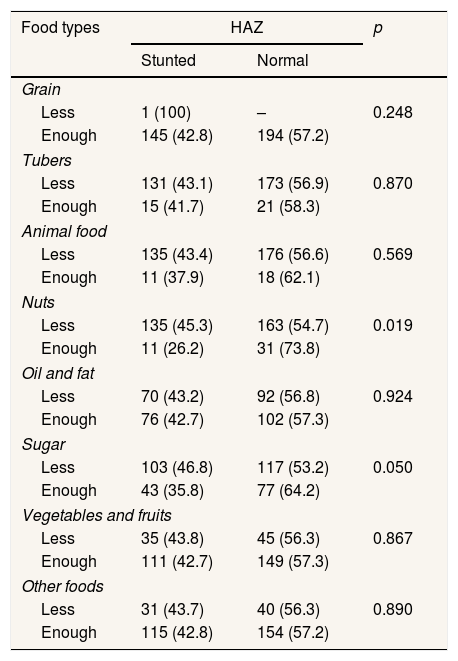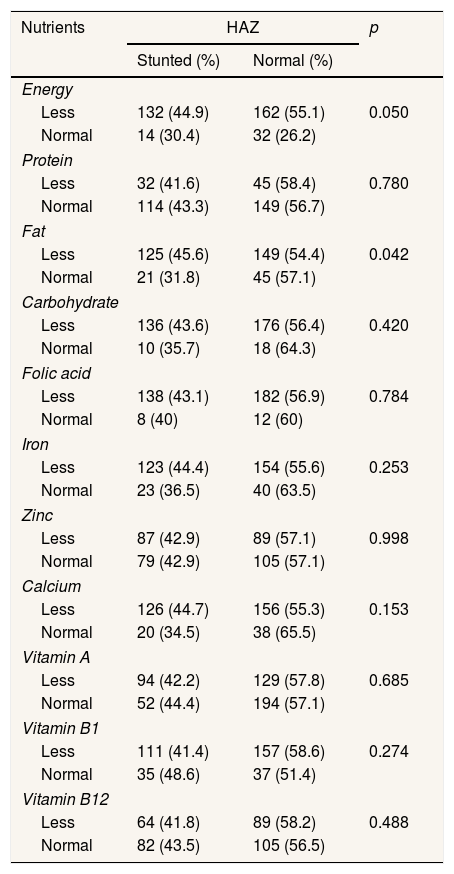
The 3rd International Nursing and Health Sciences Students and Health Care Professionals Conference (INHSP)
Más datosThe most influence of occurrence children stunted are those related to food, both in terms of quantity and quality. The aim of this study is seeing of the relationship between dietary diversity, dietary pattern and dietary intake for children stunted.
MethodsThis study is a follow up of the previous study of nutrition interventions in children, where the total sample size children was 340 measured the dietary intake with 24-hour recall. The dietary diversity and dietary patterns was measured by the FFQ (Food Frequency Questioner) form for children.
ResultsThe results showed that a lack of energy intake associated with children stunted was 132 (44.9%) (p=0.050), and lacked fat intake was 125 (45.6%) (p<0.050). For the dietary diversity there is a relationship with stunted at a mean value of 7.51±0.87 (p<0.050). As for the dietary pattern, there is a relationship between insufficient of consumption nuts and stunted (p=0.019) and foods containing sugar (p=0.050) also, namely 135 (45.3%) and 103 (43.8%).
ConclusionStunting in children is related to the quality and quantity of food.
One of the main factors causing the incidence of stunting is the inadequacy of children's nutrients that should be consumed by children based on the RDA standard from the Indonesian Ministry of Health. The inadequacy of the child's nutrition is influenced by 2 factors, namely the quality and quantity of children's food. In the section on the quality of children's food, it includes the diversity of food or the Dietary Diversity Score, while the quantity section of food includes the Dietary Pattern, which will show the frequency of children consuming various foods or foods that can support children's intake needs. Diversity has long been recognized as a key element of a high-quality diet and can be assessed using simple tools such as the dietary diversity score (DDS).1 The phase of children under 5 years of age desperately needs appropriate intake where the growth and development phases require a balance of micronutrients and macronutrients. Therefore, this research will look at the relationship between Food diversity, Food pattern, and Food intake on the incidence of stunting in children.
MethodsThis study design is a follow-up of previous research, namely nutrition intervention in pregnant and lactating women using the RCT-DB design. This study was conducted in 6 districts (Tamalatea, Bangkala, Bontoramba, Binamu, Tarowang, and Kelara) in Jeneponto district, South Sulawesi, Indonesia.2 At this time, the children born were 2 years old and the number of samples obtained was 340 children scattered in each sub-district. In this study, stunting was defined as <−2 SD height for age z score according to WHO rules.3 The determination of the z score was using the application of the WHO Anthro 2005 to maintain the accuracy of stunting determination in children. In the analysis phase, HAZ will be divided into 2 categories, namely stunted and normal. This study received Ethical Approval from the Ethics Commission of the Faculty of Public Health, Hasanuddin University with Protocol Number: 5111993028 signed on letter number 10153/UN4.14.7/TP.01.02/2019. This study is conducted since 28 November 2019 until 10 January 2020.
The independent variables consist of children's dietary diversity, children's diet, and children's dietary intake. The diversity of children's diets aims to see variations in the amount of children's food based on food genetics from the Ministry of Agriculture and FAO. The number of types of food is 9 consisting of grains, tubers, animal food, oils and fats, coconut oil or oil from plants, sugar, nuts, vegetables and fruit, and other foods.4 It is defined to be various when consuming children's food more than 6 types of food consumed in the last 1 month. The food pattern is defined to be good when the frequency of food is at least 4 times a week in consuming this type of food. Measurement of food diversity and children's dietary patterns using the FFQ (Food Frequency Questioner) method which has been tested previously on several samples.5,6 The amount of children's nutritional intake is determined based on the RDA 2020 value by the Indonesian Ministry of Health.7 Collecting food intake data using the 24-hour Recall method and calculated using the Nutrisurvey 2007 application. All tests were analyzed using SPSS 25 for mac when use chi-square test to measure difference of proportion between stunting and normal on food pattern and nutrients adequate. Measuring of food diversity use independet t-test and Mann–Whitney test because data scale in numeric form.
ResultsThe results showed that the highest frequency was at the level of mother's education, namely in the low category as many as 232 (68.2%), the same thing at the level of education of the father was at the most in the low category, namely 233 (68.5%) (see Table 1). The total score of the food diversity of children who were stunted got an average dietary diversity of 7.51±0.87, which was lower than normal children, 7.63±0.67 (p=0.040). So that it is found that there is a relationship between the diversity of children's diets with the incidence of stunted children in Jeneponto district (see Table 2).
Univariate analysis of household characteristics.
| Variables | n | % |
|---|---|---|
| Mother's education | ||
| Low (≤9 years) | 232 | 68.2 |
| Higher (>10 years) | 108 | 31.8 |
| Father's education | ||
| Low (≤9 years) | 233 | 68.5 |
| Higher (>10 years) | 107 | 31.5 |
| Mother's occupational | ||
| Working | 34 | 10 |
| IRT | 306 | 90 |
| Father's occupational | ||
| Farmer | 185 | 58.4 |
| Traders | 84 | 26.5 |
| Employees | 16 | 5 |
| Others | 32 | 10.1 |
| Family income | ||
| 81 | 23.9 | |
| IDN 1–2 million | 215 | 63.2 |
| IDN 2–3 million | 33 | 9.7 |
| ≥IDN 3 million | 11 | 3.2 |
| Smoking status | ||
| Yes | 255 | 75 |
| None | 85 | 25 |
Bivariate analysis between disversity foods and HAZ.
| Food types | HAZ | p | |
|---|---|---|---|
| Stunted | Normal | ||
| Grain | 0.99±0.08 | 1.00±0.00 | 0.250 |
| Tubers | 0.82±0.38 | 0.86±0.35 | 0.401 |
| Animal food | 0.95±0.21 | 0.97±0.15 | 0.274 |
| Nuts | 0.97±0.16 | 0.99±0.10 | 0.521 |
| Oil and fat | 0.84±0.37 | 0.86±0.34 | 0.237 |
| Sugar | 0.97±0.16 | 0.99±0.10 | 0.237 |
| Vegetables and fruits | 0.97±0.16 | 0.96±0.19 | 0.495 |
| Other foods | 0.99±0.11 | 1.00±0.00 | 0.103 |
| Food diversity | 7.51±0.87 | 7.63±0.67 | 0.040 |
In the consumption of nuts for children who were stunted, the consumption pattern of nuts in the low category was 135 (45.3%) and the consumption pattern of nuts in the moderate category was 43 (35.8%) (p=0.019). As for the category of sugar consumption, children who were stunted and lacked sugar consumption were 103 (46.8%), while children who were stunted but their sugar consumption was fulfilled only reached 43 (35.8%) with a value of p=0.05 (see Table 3). The results showed that there was a relationship between lack of energy and fat on the incidence of stunted children. More children were stunted who experienced insufficient energy consumption 132 (44.9%) than those who were stunted, but energy adequacy was met 14 (30.4%) which was significant at p=0.050. Similarly, in the category of child fat intake, were children who were stunted were more likely to have 125 (45.6%) deficient amounts of fat intake compared to children who were stunted but their nutritional fat was only 21 (31.8%) with p-value=0.042 (see Table 4).
Bivariate analysis between food pattern and HAZ.
| Food types | HAZ | p | |
|---|---|---|---|
| Stunted | Normal | ||
| Grain | |||
| Less | 1 (100) | – | 0.248 |
| Enough | 145 (42.8) | 194 (57.2) | |
| Tubers | |||
| Less | 131 (43.1) | 173 (56.9) | 0.870 |
| Enough | 15 (41.7) | 21 (58.3) | |
| Animal food | |||
| Less | 135 (43.4) | 176 (56.6) | 0.569 |
| Enough | 11 (37.9) | 18 (62.1) | |
| Nuts | |||
| Less | 135 (45.3) | 163 (54.7) | 0.019 |
| Enough | 11 (26.2) | 31 (73.8) | |
| Oil and fat | |||
| Less | 70 (43.2) | 92 (56.8) | 0.924 |
| Enough | 76 (42.7) | 102 (57.3) | |
| Sugar | |||
| Less | 103 (46.8) | 117 (53.2) | 0.050 |
| Enough | 43 (35.8) | 77 (64.2) | |
| Vegetables and fruits | |||
| Less | 35 (43.8) | 45 (56.3) | 0.867 |
| Enough | 111 (42.7) | 149 (57.3) | |
| Other foods | |||
| Less | 31 (43.7) | 40 (56.3) | 0.890 |
| Enough | 115 (42.8) | 154 (57.2) | |
Bivariate analysis between nutrients adequate and HAZ.
| Nutrients | HAZ | p | |
|---|---|---|---|
| Stunted (%) | Normal (%) | ||
| Energy | |||
| Less | 132 (44.9) | 162 (55.1) | 0.050 |
| Normal | 14 (30.4) | 32 (26.2) | |
| Protein | |||
| Less | 32 (41.6) | 45 (58.4) | 0.780 |
| Normal | 114 (43.3) | 149 (56.7) | |
| Fat | |||
| Less | 125 (45.6) | 149 (54.4) | 0.042 |
| Normal | 21 (31.8) | 45 (57.1) | |
| Carbohydrate | |||
| Less | 136 (43.6) | 176 (56.4) | 0.420 |
| Normal | 10 (35.7) | 18 (64.3) | |
| Folic acid | |||
| Less | 138 (43.1) | 182 (56.9) | 0.784 |
| Normal | 8 (40) | 12 (60) | |
| Iron | |||
| Less | 123 (44.4) | 154 (55.6) | 0.253 |
| Normal | 23 (36.5) | 40 (63.5) | |
| Zinc | |||
| Less | 87 (42.9) | 89 (57.1) | 0.998 |
| Normal | 79 (42.9) | 105 (57.1) | |
| Calcium | |||
| Less | 126 (44.7) | 156 (55.3) | 0.153 |
| Normal | 20 (34.5) | 38 (65.5) | |
| Vitamin A | |||
| Less | 94 (42.2) | 129 (57.8) | 0.685 |
| Normal | 52 (44.4) | 194 (57.1) | |
| Vitamin B1 | |||
| Less | 111 (41.4) | 157 (58.6) | 0.274 |
| Normal | 35 (48.6) | 37 (51.4) | |
| Vitamin B12 | |||
| Less | 64 (41.8) | 89 (58.2) | 0.488 |
| Normal | 82 (43.5) | 105 (56.5) | |
Children who are stunted tend to have a low diversity of their diet compared to well-nourished children. Stunting occurs due to deficiencies of nutrients both in the form of micronutrients and macronutrients, but more often occurs due to micronutrient deficiencies.8 Nutrients in the form of micronutrients are more commonly found in vegetables and fruit or some other foods such as tubers or other foods.9 The variety of children's food consumption provides a great opportunity to meet children's nutritional needs. When children only eat enough animal food but without food in the fruit and vegetable groups, it will also affect the large absorption of protein in animal food. In the human body requires a diversity of nutrients that support each other in the process of food synthesis, such as the process of protein synthesis requiring micronutrients to assist in absorption to become ATP or to become food reserves in the body.10 Likewise, when children only eat vegetables and fruit without animal food or tubers or other foods will also have an impact on the adequacy of macronutrient intake. The vegetable and fruit group cannot provide as much carbohydrate as the grains group, cannot provide as much and fresh protein as in the animal food group and fats that are good for health as in the nuts and oil and fat groups.11
Children's dietary patternChildren's dietary patterns are related to the frequency of children's food in a certain period which will give birth to a discrete pattern. This prolonged diet will have a big impact on children under the age of five. The age of children under five years is a critical phase to be given attention to their food or food habits. The incidence of stunting is a prolonged incidence of nutritional deficiency (chronic nutrition) so that it is closely related to food habits or dietary patterns of children.12 When you are deficient in these nutrients for a long time, the low frequency of consuming these foods will have the potential for the incidence of stunting. It is clear that protein and fat are macronutrients that are needed by children during their infancy13, as well as folate and vitamin C are used as the formation of tissues in the body and also play a role in children's immunity.14 Furthermore, The role of carbohydrates or other sugars in the body plays a role in increasing the synthesis of food to become ATP.15 Another important function of sugar consumption is because it influences the formation of galactose, fructose, and lactose in the body, where these sugars play an important role in the formation of enzymes and recent findings show other types of sugar have an effect on gut health.
Children's dietary intakeIf food intake occurs over a long period of time, it will be the biggest risk factor for stunting. In this study, it was found that children who consumed less energy and fat intake were associated with the incidence of stunting. Children who experience a lack of energy intake are more likely to suffer from stunting than children who have enough energy intake. Likewise, with the total fat intake of children, children with less fat intake were stunted more than children with adequate fat intake. Energy and fat are macronutrients, which means that they are needed in the body so that when they are deficient, they will have an impact on the body.16 Lack of energy will affect all activities both outside the body and inside the body. In the body, energy plays an important role in everything related to the synthesis and absorption of nutrients. When energy is not sufficient, this will also have an impact on other nutrients in the absorption phase. The lack of fat intake will have an impact on the fat synthesis, where this fat serves as a substance needed for children's growth.17 Lack of energy intake in children is in line with the child's lack of sugar consumption, as well as the lack of fat intake in line with the consumption pattern of nuts are lacking as previously described.
ConclusionThe incidence of stunting in food factors is influenced by the quality and quantity of food. The quality of food is related to the variety of children's food, and the quantity of food is related to the child's diet, while both the quality and quantity of children are determined by the amount of food intake of the child. Children who eat a variety of foods accompanied by a more dietary pattern according to the recommendations will automatically increase the amount of food intake and will avoid deficiencies of micro and macronutrients.
Conflict of interestThe authors declare no conflict of interest.
We would like to thank all the enumerator teams who have provided assistance in data collection and the research team who have contributed since data collection until the publication phase
Peer-review under responsibility of the scientific committee of the 3rd International Nursing, Health Science Students & Health Care Professionals Conference. Full-text and the content of it is under responsibility of authors of the article.

















